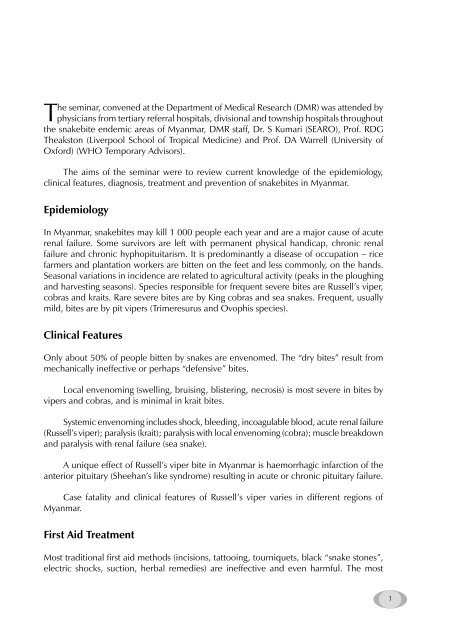Management of Snakebite and Research Management of Snakebite ...
Management of Snakebite and Research Management of Snakebite ...
Management of Snakebite and Research Management of Snakebite ...
You also want an ePaper? Increase the reach of your titles
YUMPU automatically turns print PDFs into web optimized ePapers that Google loves.
The seminar, convened at the Department <strong>of</strong> Medical <strong>Research</strong> (DMR) was attended by<br />
physicians from tertiary referral hospitals, divisional <strong>and</strong> township hospitals throughout<br />
the snakebite endemic areas <strong>of</strong> Myanmar, DMR staff, Dr. S Kumari (SEARO), Pr<strong>of</strong>. RDG<br />
Theakston (Liverpool School <strong>of</strong> Tropical Medicine) <strong>and</strong> Pr<strong>of</strong>. DA Warrell (University <strong>of</strong><br />
Oxford) (WHO Temporary Advisors).<br />
The aims <strong>of</strong> the seminar were to review current knowledge <strong>of</strong> the epidemiology,<br />
clinical features, diagnosis, treatment <strong>and</strong> prevention <strong>of</strong> snakebites in Myanmar.<br />
Epidemiology<br />
In Myanmar, snakebites may kill 1 000 people each year <strong>and</strong> are a major cause <strong>of</strong> acute<br />
renal failure. Some survivors are left with permanent physical h<strong>and</strong>icap, chronic renal<br />
failure <strong>and</strong> chronic hyphopituitarism. It is predominantly a disease <strong>of</strong> occupation – rice<br />
farmers <strong>and</strong> plantation workers are bitten on the feet <strong>and</strong> less commonly, on the h<strong>and</strong>s.<br />
Seasonal variations in incidence are related to agricultural activity (peaks in the ploughing<br />
<strong>and</strong> harvesting seasons). Species responsible for frequent severe bites are Russell’s viper,<br />
cobras <strong>and</strong> kraits. Rare severe bites are by King cobras <strong>and</strong> sea snakes. Frequent, usually<br />
mild, bites are by pit vipers (Trimeresurus <strong>and</strong> Ovophis species).<br />
Clinical Features<br />
Only about 50% <strong>of</strong> people bitten by snakes are envenomed. The “dry bites” result from<br />
mechanically ineffective or perhaps “defensive” bites.<br />
Local envenoming (swelling, bruising, blistering, necrosis) is most severe in bites by<br />
vipers <strong>and</strong> cobras, <strong>and</strong> is minimal in krait bites.<br />
Systemic envenoming includes shock, bleeding, incoagulable blood, acute renal failure<br />
(Russell’s viper); paralysis (krait); paralysis with local envenoming (cobra); muscle breakdown<br />
<strong>and</strong> paralysis with renal failure (sea snake).<br />
A unique effect <strong>of</strong> Russell’s viper bite in Myanmar is haemorrhagic infarction <strong>of</strong> the<br />
anterior pituitary (Sheehan’s like syndrome) resulting in acute or chronic pituitary failure.<br />
Case fatality <strong>and</strong> clinical features <strong>of</strong> Russell’s viper varies in different regions <strong>of</strong><br />
Myanmar.<br />
First Aid Treatment<br />
Most traditional first aid methods (incisions, tattooing, tourniquets, black “snake stones”,<br />
electric shocks, suction, herbal remedies) are ineffective <strong>and</strong> even harmful. The most<br />
1









